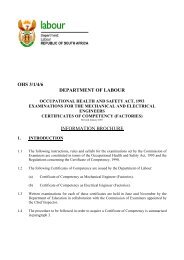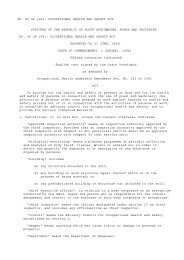Health and Safety in Chemical Industries.pdf - Department of Labour
Health and Safety in Chemical Industries.pdf - Department of Labour
Health and Safety in Chemical Industries.pdf - Department of Labour
You also want an ePaper? Increase the reach of your titles
YUMPU automatically turns print PDFs into web optimized ePapers that Google loves.
Sk<strong>in</strong> should be protected<br />
aga<strong>in</strong>st exposure to chemicals<br />
<strong>Chemical</strong> burns susta<strong>in</strong>ed<br />
from sulphuric acid spilled<br />
from car battery<br />
Contact dermatitis caused by chemicals<br />
Contact dermatitis is <strong>in</strong>flammation <strong>of</strong> the sk<strong>in</strong> caused by contact with a wide range <strong>of</strong> materials, most<br />
commonly contact dermatitis <strong>in</strong> the workplace is caused by chemicals. The most commonly affected area on<br />
the body is the h<strong>and</strong>s.<br />
The severity <strong>of</strong> contact dermatitis depends on many factors:<br />
• Characteristics <strong>of</strong> the hazardous agent<br />
• Concentration <strong>of</strong> the hazardous agent<br />
• Duration <strong>and</strong> frequency <strong>of</strong> exposure to the hazardous agent<br />
• Environmental factors (temperature, humidity)<br />
• Condition <strong>of</strong> the sk<strong>in</strong> (damaged sk<strong>in</strong>, dry or wet).<br />
Avoid<strong>in</strong>g contact with chemicals will prevent contact dermatitis. Avoid contact<br />
through the follow<strong>in</strong>g methods:<br />
• Substitute a hazardous material with a safer alternative<br />
• Automate the process<br />
• Enclose the process<br />
• H<strong>and</strong>le materials mechanically<br />
• Don’t h<strong>and</strong>le materials directly with h<strong>and</strong>s<br />
• Observe a safe work distance.<br />
If contact cannot be avoided, the sk<strong>in</strong> will need protection:<br />
• Tra<strong>in</strong> workers on risks <strong>of</strong> chemicals they use <strong>in</strong> the workplace<br />
• Promote good personal hygiene<br />
• Provide wash<strong>in</strong>g facilities, <strong>in</strong>clud<strong>in</strong>g soap <strong>and</strong> dry<strong>in</strong>g facilities<br />
• Provide proper protective equipment (gloves, aprons)<br />
• Tra<strong>in</strong> workers on the correct use <strong>of</strong> protective equipment<br />
• Replace protective equipment when necessary.<br />
Information workers should know regard<strong>in</strong>g hazardous chemicals<br />
An employer shall, ensure that the employee is adequately tra<strong>in</strong>ed with regard to:<br />
• The contents <strong>of</strong> the regulations for hazardous chemical substances<br />
• Potential source exposure to chemicals<br />
• Potential risks to health caused by exposure<br />
• Potential detrimental effect <strong>of</strong> exposure on his/her reproductive ability<br />
• Measures taken by the employer to protect employees aga<strong>in</strong>st any risk from exposure<br />
• Precautions to be taken by an employee to protect himself aga<strong>in</strong>st the health risks<br />
associated exposure<br />
• Correct use, ma<strong>in</strong>tenance <strong>of</strong> safety equipment, facilities <strong>and</strong> eng<strong>in</strong>eer<strong>in</strong>g controls<br />
• Importance <strong>of</strong> good housekeep<strong>in</strong>g at the workplace <strong>and</strong> personal hygiene<br />
• Safe work<strong>in</strong>g procedures<br />
• Procedures to be followed <strong>in</strong> the event <strong>of</strong> spillages or leakages.<br />
<strong>Health</strong> <strong>and</strong> <strong>Safety</strong> <strong>in</strong> the <strong>Chemical</strong> Industry 5

















